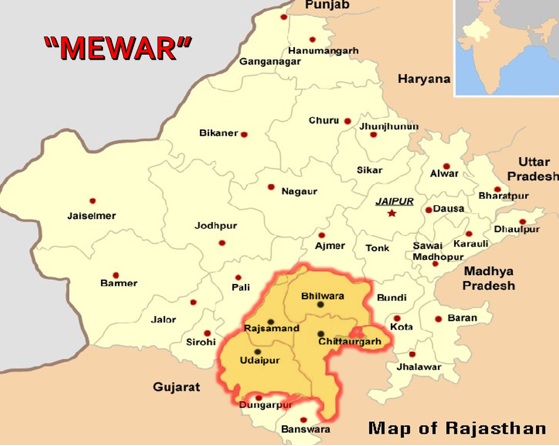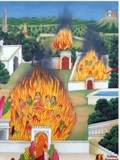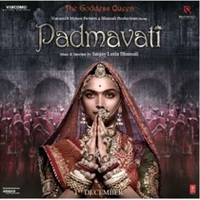History of Rani Padmavati

The Kingdom of Mewar

- Founded by Guhil in 6th century – Guhilots
- Bappa Rawal can be considered the true founder/ first powerful ruler.
- ~730 CE
- Conquered Chittor from Mori/Mauryas
- Bappa Rawal and rulers of Mewar fought against the armies of Abbasid Caliphate and Sindh for centuries.

Rani Padmavati/ Padmini
- Daughter of Punyapal Bhati of Pungal(Jaiselmar) according to Rajasthani Literature and folktales
- Wife of Rawal Ratan Singh, the rular of Mewar/Chittor in 1303 AD when Alauddin Khilji attacked.
Why did Alauddin Khilji Attack Mewar?

- Expansionist policy
- Ambitions of becoming the second Alexander
- Crucial route to ports of Gujarat
- Strengthening the flank of the Sultanate

So where does this legend/myth of Alauddin attacking Chittor for the beauty of Queen Padmini come from ?
Malik Mohd. Jayasi’s Padmavat mahakavya
Written in 1540 AD in Awadhi language.
A Poet, a parrot and a mirror
- Parrot – Spoke about beauty of Padmini to Ratan Singh
- He went to Sinhal dvipa to marry her in Swaymvara.
- Painter/Singer/Artist Raghav Chetan banished by Ratan Singh
- Raghav went to Alauddin Khilji and spoke about the Queen’s Beauty.
- Alauddin Khilji laid siege of Chittor fort for 8 months.
- He demanded to see the Rani once to end hostilities.
- Rani Padmavati and Ratan Singh agreed to Sultan’s demand – but only a reflection of her, not in person.
- Rawal Ratan Singh kidnapped by Alauddin Khilji by treachery.
- Rani Padmavati sent the best soldiers of Chittor to Delhi, disguised as maid servants and palanquin bearers.
- In a surgical strike, the soldiers liberated Rawal Singh and fled back to Chittor.
- Gora and Badal – two brave army commanders who laid down their lives while fighting.
- Alauddin Khilji’s army was superior and ultimately captured Chittor after a fierce battle with the Rajput army.
- 16000 women of the fort, led by Rani Padmavati committed JAUHAR(self immolotion).
Jauhar –

- Custom of mass self-immolation by women, to avoid capture, enslavement and rape by invading army, when facing certain defeat during a war.
- The moment the Rajput ladies and the children would realise that the outcome of the Battle is against the Rajputs, and there is no chance of a win, the women of the fort would commit mass self-immolation.
- They would wear their wedding dress, hold the hands of their children, and lunge into a colossal pyre – preferring death over dishonour by the invaders.
- This practice was mainly carried out in the night with the Vedic chants.

Saka –
- The Ritual march to the battlefield expecting certain death.
- Next morning, the Rajput men would get out of the palace with a die-hard attitude to annihilate the enemies. They would fight fiercely till they breathed their last.
- This day would start with all the Rajput men taking a bath, wearing saffron, applying the ash from the previous night of the maha samadhi on their forehaed, and then venturing out like a warrior.
Other famous Saka and Jauhars
- Jaiselner – 1295 and 1326
- Ranthambore – 1301
- Siwana(Marwar) – 1310, 1595
- Jalore(Marwar) – 1311
- 2nd Jauhar of Chittorgarh – 1535 – Bahadur Shah of Gujarat
- 3rd Jauhar of Chittorgarh – 1568 – Akbar’s attack
- Chanderi(Madhya Pradesh) – 1528 and 1543
The Film and Controversy

- Award winning Bollywood director Sanjay Leela Bhansali has made a movie on Rani Padmavati based on Jayasi’s account.
- Rajput organisations like Rajput Karni sena, Rajput sabha have raised objections regarding the film.
- Many politicians of BJP as well as Congress have also supported them.
- A film crew was attacked in Jaipur while shooting took place in January 2017, a set was burned down in Kohlapur and the organisations have even threatened the filmmakers with violence before the release of the film.
Objections raised by Rajput community and organisations
- Distortion of historical facts for entertainment and profit.
- Alleged indecent scenes portraying the Queen with Alaudeen Khilji when Rani Padmavati is considered as a local deity and the epitome of sacrifice and courage by the people of Rajasthan and Rajput especially.
- Wrong portrayal of Rajput traditions and customs – misappropriation of an entire living culture.
Counter Arguments raised by film fraternity and civil society members
- Freedom of speech and expression of filmmakers
- The film endeavours to portray the valour of the queen to a large audience in India and the entire world.
- Cinematic licence has to be taken as a film is for entertainment.
- Violence in a civilised society is unacceptable.
Facts About Padmavati

- Rani Padmavati is also known as Rani Padmanini. She was a legendary Indian queen of 13th-14th century.
- The earliest source to mention her is an epic poem titled “Padmavat” written by a 16th-century Sufi-poet Malik Muhammad Jayasi. The epic poem was written in Awadhi language in 1540 CE.
- According to Padmavat, she was born to Gandharv Sen, the king of the Singhal kingdom and her mother name was Champavati. Her religion was hindu. She belonged to Kshatriya(Rajput).

- Her father Gandherv Sen was very protective of her and didn’t like anybody to talk to her. Eventually, she became close friends with a talking parrot named Hiraman.
- When his father heard about parrot’s closeness to his daughter, her ordered the parrot to be killed. However, the parrot flew away and saved its life. Meanwhile, a bird-catcher trapped the parrot and sold it to a brahmin Raghav.
- The Brahmin Raghav took the parrot to Chittor, where Ratan Singh(King of Chittor) purchased it; as he was impressed by its talking ability.
- The parrot eulogized the mesmerizing beauty of Rani Padmavati in front of Ratan Sen, who decided to marry Padmavati. He started marching towards the Singhal Kingdom accompanied by his 16,000 followers and after crossing the seven seas, he reached there.
- Ratan Singh, along with his followers, attacked the royal fortress of Singhal kingdom. However, they are defeated and imprisoned.
- When Ratan Singh was about to be executed, his royal bard revealed to the captors that he was the King of Chittor. After hearing that, Gandharv Sen decided to marry Padmavati with Ratan Sen and also arranged 16,000 padmini(women of Singhal Kingdom) for the 16,000 men accompanying Ratan Sen.
- Soon, Ratan Sen, received a message through a messenger bird that his first wife, Nagmati, is longing for him back in Chittor. Ratan Singh decided to return to Chittor. On his way to Chittor, the Ocean God punished him for inculcating excessive pride in winning over the world’s most beautiful woman.However, Ratan Singh passed the anguished of Ocean God and finally returned to Chittor.
- After some time, a Brahmin named Raghav Chetan, Who was banished by Ratan Singh, visited the court of Alauddin Khilji, the sultan of Delhi and told him about the mesmerizing beautiful Padmavati.
- Alauddin decided to obtain Padmavati and besieged Chittor. When Ratan Singh offered him tribute but refused to give away Padmavati. Then Alauddin Khilji deceitfully captured Ratan Sen and took him to Delhi.
- Padmavati sent two Ratan Sen’s loyal feudatories Gora and Badal to Delhi to rescue Ratan Sen. Gora and Badal disguised as Padmavati and her female companions and rescued Ratan Sen. While they were killed but Ratan Singh reached Chittor safely.
- When Ratan Sen was imprisoned in Delhi, Devpal, the Rajput king of Chittor’s neighbour- Kumbhalner, had also been infatuated with Padmavati and proposed her for marriage through an emissary.
- After returning to Chittor, Ratan Sen decided to take revenge with Devpal. In singal combat, Devpal and Ratan Sen killed each other.
- Meanwhile, Alauddin Sen again attacked Chittor to obtain Padmavati. Realising the defeat against Alauddin, Padmavati and Nagmati committed self-immolation on Ratan Sen’s funeral pyre.
- Other women of Chittor also committed a mass self-immolation(Jauhar). While fighting against Alauddin, all men of Chittor died and Alauddin emerged victorious and acquire nothing but empty fortress.
While the seige of Chittor by Alauddin in 1303 CE is a historical figure and appeared in several plays, novels, telefims and movies.
Several films on Rani Padmavati have been made in India. The earliest known film on Rani Padmavati was Debaki Bose’s silent film – “Kamonar Agun” or “Flames of Flesh”(1930)
The first Hindi film on Rani Padmavati was Maharani Padmini(1964).
Controversial film named ‘Padmavati’ changed name to Padmavat; as the film fell into controversy for distorting the historical facts as claimed by fringe groups including Likendra Singh Kalvi led Kerni Sena.
Other References
- Muslim/Sultanate Historians :
Amir Khusro – Khaza ‘ in ul-Futuh(The Treasure of Victory)
Indirect/veiled reference to Padmavati
but clearly mentioned Jauhar of Ranthambore.
- 1589 – Hemratan comosed Gora Badal Padmini Chaupai
- The ballads and folk song of Rajasthan
- An annual fair held in Chittor to commemorate the event – Jauhar mela
- Mant later adaptations in Bengal in 19th and 20th century.
Thank you and All the best!!
You can join or visit at Facebook Page or Twitter for always keep in touch with further updates
Read more articles….
